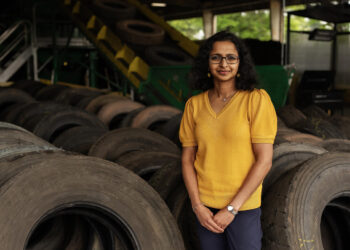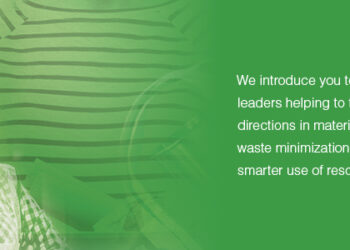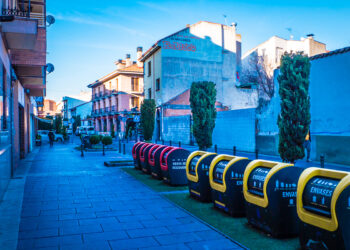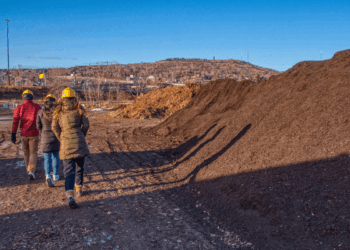This article appeared in the September 2024 issue of Resource Recycling. Subscribe today for access to all print content.
Glass Half Full, a Gulf Coast glass processor with an environmental focus, needed a bigger facility as soon as its first one opened, CEO Franziska Trautmann said in a recent interview. As the concrete slab for a new facility is poured on the coast of Louisiana, she’s already imagining the 3 acres filled with glass.
“We pretty much said go big,” Trautmann said. “Ever since we started, it’s always felt like there was more demand for glass recycling than we’ve been able to handle. It’s always felt like we were piling up glass and struggling to process it and satisfy everyone.”
The new facility, located on a capped landfill in Chalmette, Louisiana, is sited on 3 acres of land and will be indoor-outdoor, she said. It should be operational by early 2025, and at full capacity could handle up to 150 tons of glass per day.
That’s needed capacity, because Trautmann’s vision is to handle all the glass within a 200-mile radius of New Orleans.
“There’s always been a huge lack of glass recycling in the region, and so we’ve always felt like the only way to go is up,” she said. “Louisiana and Mississippi, especially, consistently are toward the bottom of the list in terms of recycling as a state, and so we’re trying to just reach out to these communities. We just launched in Mobile, Alabama. We’re starting to expand where we can collect from, so we can just fill this plant with glass and get as much recycled as possible.”
Glass is easy in theory to recycle, but it’s hard to transport, heavy and difficult to collect. If it runs through a MRF, contamination rates are high. And the domestic industry has been in flux lately, with several facility closures and bankruptcies. As Glass Half Full illustrates, there are nonetheless hopeful spots.
Bob Hippert, sustainability strategy leader for manufacturing at O-I Glass, said glass recycling as a whole is in an interesting place. O-I has a network of manufacturing facilities but also has two glass-to-glass facilities that recycle glass into cullet in Oregon and Colorado. He pointed to the April acquisition of Strategic Materials by European glass recycling powerhouse Sibelco as an event that will spark a lot of domestic change.
“I actually think we’re in a good position, because there’s been a lack of investment in the cullet and the glass recycling processing area in the U.S. for probably the last 10 to 15 years,,” Hippert said. “I believe that what Sibelco is going to bring to the table is some renewed investment in a way that’s going to help drive improved quality of the furnace-ready cullet that can be used by glass plants, but also at a time when we’ve really seen kind of a degradation in the amount of material available in the market.”
Growing out of modest roots
Glass Half Full started in a backyard in 2020, with Trautmann and co-founder Max Steitz looking to recycle glass bottles from their friends and themselves. Word got out, demand exploded, and soon the business was moving into a 40,000-square-foot facility. But in 2022, the founders saw a need to scale up.
“We started fundraising at least a year and half ago, seriously, trying to raise some funds,” Trautmann said. “It was definitely a long time coming, and finally in April or so, all of the pieces started fitting together.”
That included a seed funding round that raised $6.5 million, led by Benson Capital Partners and supported by Momentum Fund and Innovation Catalyst. The Meraux Foundation and AMCREF Community Capital also supported the expansion.
“We are thrilled to partner with Glass Half Full to help further the company’s mission towards sustainability,” Gayle Benson, BCP’s founder, said in a written statement. “Through our combined dedication to green jobs and coastal restoration, we are excited to propel access to glass recycling for the entire Gulf South region.”
Back in 2022, Glass Half Full had five employees and 1,000 volunteers collecting 100,000 pounds of glass a month through neighborhood pickup and drop-off programs, grinding it into sand to be used in sandbags and coastal restoration pilot projects.
Now there are more than 20 employees, as well as a fleet of trucks and vans to do commercial and residential collection. The new facility will have enough space to allow Glass Half Full to produce cullet as well as satisfy the growing demand from restoration projects and for sandbags.
A local environmental benefit
Glass Half Full’s work falls at the intersection of two major sustainability issues: the immense global demand for sand and the widespread loss of beaches and coastlines, including along the Gulf. Human usage of sand for concrete, glass and other applications exceeds its natural production, according to a 2019 UN report. And the U.S. National Oceanic and Atmospheric Administration has reported that climate change and other forces have eroded coastal beaches and wetlands, making the region more vulnerable to severe storms and sea level rise.
The sand that Glass Half Full produces completed baseline safety testing for Louisiana marsh restoration and has now moved on to demonstration projects — one of which is right next door to the new facility, Trautmann said.
Two new islands have been built there and planted with marsh grass. One island is made of sand from Glass Half Full and the other from sediment dredged from the Mississippi River. Over the next five years, researchers will monitor both islands to see if there are any differences between the two.
The Coalition to Restore Coastal Louisiana and the Pointe au Chien Indian Tribe have also received sand for restoration projects. Next up are dune and beach restoration projects, in and out of the state, Trautmann added, and there is governmental interest from as far away as Delaware.
Commercial recycling and drop-off bring in the most volume, Trautmann said, but the company is also expanding its services into Jefferson Parish, St. Bernard, Slidell, Mandeville, Covington and Baton Rouge in Louisiana, as well as Birmingham, Alabama, and Bay St. Louis, Mississippi.
In Jefferson Parish, close to New Orleans, Glass Half Full is experimenting with single-stream recycling collection, which goes to a local MRF. But glass is still the focus, Trautmann said.
“It feels like there’s a lot of glass out there just going straight to landfill,” Trautmann said — less than a third of glass containers were recycled in the U.S. in 2018, according to the U.S. EPA’s most recent estimate.
“There’s so much potential in how much we can grow glass recycling across the U.S. and especially for us, we’re pretty focused on the South and Southwest, Louisiana, Mississippi, Alabama, Florida,” she continued. “We want to ideally be in those states collecting millions and millions of bottles and turning them into a useful resource.”
The Glass Recycling Coalition and other glass recyclers have been supportive since the beginning, Trautmann added.
“SMI, Ripple, there are a lot of great people in the industry. We have a common goal of recycling more glass.”

The wider industry picture
Looking to packaging extended producer responsibility laws, Hippert at O-I said he’s pushing for deposit return systems to be paired up with the incoming legislation in states where there’s not an existing bottle bill, such as Colorado.
“If you just have an EPR (program), you lose sight of a lot of potential glass and a lot of material streams, so to me it’s really important that you’re able to capture all that,” he said.
In addition, DRS programs tend to provide a much cleaner stream of material.
“They really protect quality and minimize contamination of the various streams, whether it be aluminum, plastics or glass, versus single-stream where everything gets commingled and you have to try to unscramble the egg,” Hippert said.
In EPR states that already have DRS, such as Oregon and California, Hippert is working with CAA, “making sure that they know that the glass has got a home in Oregon.”
California will also be a state to watch, Hippert noted. California used to be a net exporter of glass for recycling, Hippert said, but now in order to meet its longstanding minimum recycled content mandates, the state is importing glass – and there are some new players in the market, such as Gallo, which may have contributed to Strategic Materials filing for bankruptcy last year, before it was bought by Sibelco.
Looking ahead
What comes next in the industry? O-I is not planning to build any more glass-to-glass plants of its own, Hippert said, but the company is scaling up the amount of recycled content it uses.
Jim Woods, who is in corporate affair for O-I Glass, added that O-I has “ambitious sustainability goals to increase our cullet use,” which include increasing recycled content 50% by average by 2030.
“That is why Bob and everybody are doing this work in improving recycling,” he said. “We want more cullet.”
O-I is setting itself up for a future of more demand for glass and glass recycling, especially with incoming recycled content mandates and consumer desire to move to non-plastic packaging.
“People are looking back to glass,” Woods said. “It just makes sense from a business and an environmental perspective to use as much recycled glass as we can.”
In addition, Hippert said he is looking to improve efficiency at the Denver glass-to-glass facility, which O-I purchased from Momentum Denver in May 2022. The two companies had formerly worked together before Momentum ran into trouble.
Today, the Denver plant is running at 40% or 50% capacity “because they can’t get enough glass in the front door,” he added, and it’s largely MRF glass. While he anticipates more funding coming out of the EPR program for glass clean up systems, those are still years away.
“Everyone is kind of like, all right, let’s wait and see what happens. And so that’s the challenge where we’re butting up against right now,” he said.


























